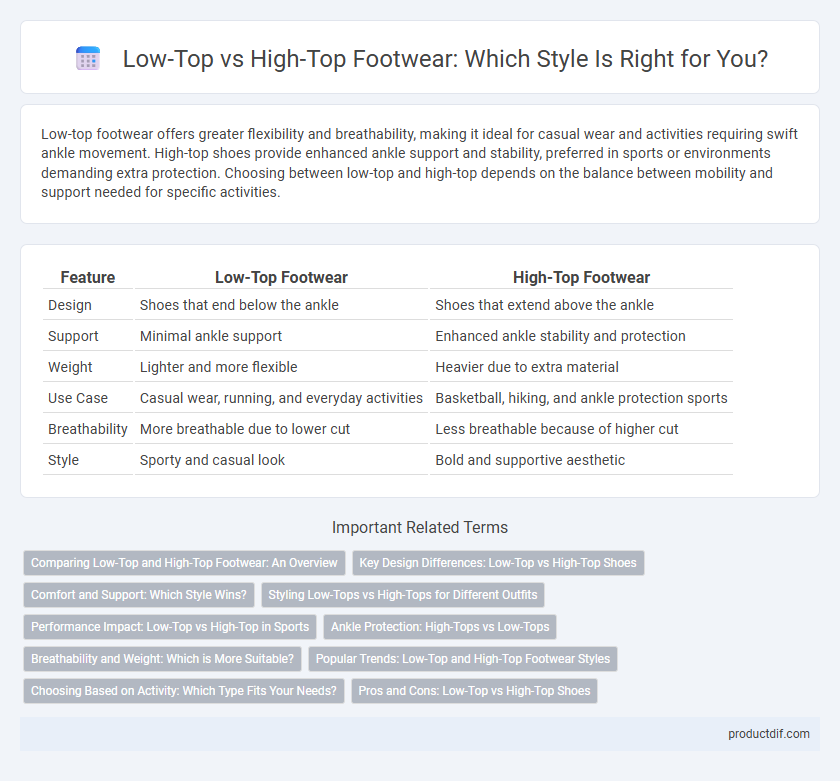Low-top footwear offers greater flexibility and breathability, making it ideal for casual wear and activities requiring swift ankle movement. High-top shoes provide enhanced ankle support and stability, preferred in sports or environments demanding extra protection. Choosing between low-top and high-top depends on the balance between mobility and support needed for specific activities.
Table of Comparison
| Feature | Low-Top Footwear | High-Top Footwear |
|---|---|---|
| Design | Shoes that end below the ankle | Shoes that extend above the ankle |
| Support | Minimal ankle support | Enhanced ankle stability and protection |
| Weight | Lighter and more flexible | Heavier due to extra material |
| Use Case | Casual wear, running, and everyday activities | Basketball, hiking, and ankle protection sports |
| Breathability | More breathable due to lower cut | Less breathable because of higher cut |
| Style | Sporty and casual look | Bold and supportive aesthetic |
Comparing Low-Top and High-Top Footwear: An Overview
Low-top footwear offers greater ankle mobility and is preferred for activities requiring speed and agility, such as running. High-top shoes provide enhanced ankle support and stability, making them ideal for sports like basketball and hiking. The choice between low-top and high-top depends on the level of ankle protection needed and the specific athletic or casual use.
Key Design Differences: Low-Top vs High-Top Shoes
Low-top shoes feature an ankle-bone cut that offers enhanced mobility and a lightweight feel, ideal for activities requiring agility and speed. High-top shoes extend above the ankle, providing increased support and stability, which is beneficial for sports like basketball or hiking where ankle protection is critical. The key design difference lies in the collar height, influencing both the level of ankle support and overall flexibility of the footwear.
Comfort and Support: Which Style Wins?
Low-top sneakers offer greater flexibility and lighter weight, making them ideal for activities requiring agility and prolonged wear, while high-tops provide enhanced ankle support and stability, reducing the risk of injuries during dynamic movements. Research in footwear biomechanics shows that high-tops distribute pressure more evenly around the ankle, benefiting athletes and individuals prone to ankle sprains. Consumer reviews highlight that comfort preferences often depend on specific use cases, with low-tops favored for casual wear and high-tops preferred in sports demanding lateral support.
Styling Low-Tops vs High-Tops for Different Outfits
Low-top sneakers offer a sleek, minimalist look that complements casual and athletic wear, enhancing the versatility of jeans, shorts, and tailored trousers. High-top sneakers provide a bold statement piece, ideal for streetwear and layering with joggers, hoodies, and oversized jackets. Styling low-tops focuses on streamlined, clean silhouettes, while high-tops add an edgy, urban vibe to outfits.
Performance Impact: Low-Top vs High-Top in Sports
Low-top basketball shoes offer increased ankle mobility, enhancing speed and agility needed for quick cuts and fast breaks, while high-top shoes provide superior ankle support that reduces injury risk during lateral movements and jumps. Studies show athletes wearing high-tops experience fewer ankle sprains, particularly in sports involving frequent jumps and pivoting. However, low-tops often result in faster sprint times due to their lighter weight and flexible design, benefiting players who prioritize speed over stability.
Ankle Protection: High-Tops vs Low-Tops
High-top footwear offers superior ankle protection by providing extended coverage and support, which helps prevent sprains during physical activities. Low-top shoes allow for greater mobility but expose the ankle to higher risk of injury due to less coverage. Athletes engaging in sports with frequent lateral movements often prefer high-tops to reduce ankle instability and enhance safety.
Breathability and Weight: Which is More Suitable?
Low-top footwear typically offers superior breathability due to its open design, allowing better air circulation that helps in keeping feet cool and dry. High-top shoes, while providing more ankle support, often weigh more and can trap heat, reducing overall comfort during extended wear, especially in warm conditions. For activities prioritizing ventilation and lightweight comfort, low-tops are generally the more suitable choice.
Popular Trends: Low-Top and High-Top Footwear Styles
Low-top sneakers dominate casual and athletic footwear trends due to their lightweight design and versatility, making them ideal for everyday wear and running. High-top shoes gain popularity in streetwear and basketball communities, offering enhanced ankle support and a bold style statement. Both styles balance comfort and fashion, with brands integrating innovative materials and vibrant colorways to appeal to diverse consumer preferences.
Choosing Based on Activity: Which Type Fits Your Needs?
Low-top footwear offers greater ankle mobility and lighter weight, ideal for running, gym workouts, and casual wear where flexibility and speed are priorities. High-top shoes provide enhanced ankle support and stability, making them suitable for basketball, hiking, and activities involving lateral movements or uneven terrain. Selecting between low-top and high-top depends on your specific activity demands, injury history, and comfort preferences to optimize performance and reduce the risk of injury.
Pros and Cons: Low-Top vs High-Top Shoes
Low-top shoes offer greater flexibility and lighter weight, making them ideal for activities requiring speed and agility but provide less ankle support and protection. High-top shoes enhance stability and help prevent ankle injuries, beneficial for sports with lateral movements, though they can be heavier and restrict some range of motion. Choosing between low-top and high-top footwear depends on prioritizing mobility or ankle support based on specific activity needs.
Low-top vs High-top Infographic

 productdif.com
productdif.com